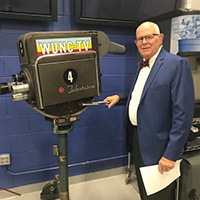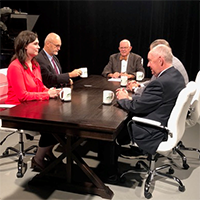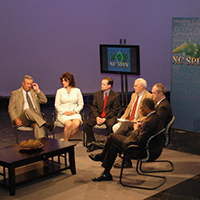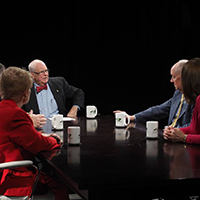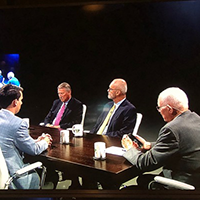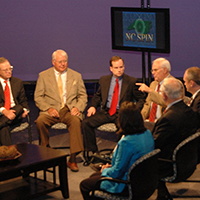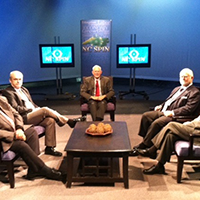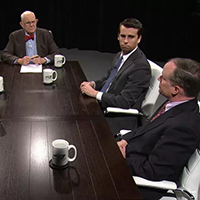As US, NC homelessness numbers rise, officials and nonprofits make headway in helping veterans
Published February 20, 2025
An 8% reduction in the number of veterans experiencing homelessness on a given night in January 2024 is the lone bright spot in an otherwise grim U.S. Department of Housing and Urban Development (HUD) report documenting homelessness in America.
The report found 770,000 Americans — an 18% increase over the previous year — experiencing homelessness on that January night. It was the largest number recorded since HUD began conducting the counts in 2005.
HUD’s 2024 Annual Homelessness Assessment Report (AHAR) found that the number of people experiencing homelessness increased in every category — except for veterans — measured during the department’s annual Point-in-Time (PIT) Count. The count is a snapshot of the number of individuals in shelters, temporary housing and unsheltered on a single night.
According to the 2024 PIT Count, there were 32,882 veterans experiencing homelessness — 2,692 fewer than the 35,574 recorded in 2023. About six in every 10 were sheltered and the other four in 10 were unsheltered, meaning they didn’t have a regular place to stay and sleep in places not meant for human habitation. Veterans made up 5% of all adults experiencing homelessness.
North Carolina is home to 10 military installations with more than 89,000 active-duty personnel, many of whom remain here after separating from the military. As of 2024, there were an estimated 800,000 veterans living in the state. The PIT Count found 688 veterans experiencing homelessness. That was an 11% decrease over the 777 recorded in 2023.
Bucking a general trend
The modest positive news on veterans’ homelessness was an exception to the overall trend in North Carolina and elsewhere. Total homelessness across the state jumped 19% to 11,626 in 2024. That was 1,872 more than the 9,754 counted in 2023.
“We’ve seen these numbers increase over and over and over,” said Dr. Latonya Agard, executive director for the North Carolina Coalition to End Homelessness, during a recent discussion about the AHAR report at a discussion sponsored by the North Carolina Housing Coalition.
The largest increase North Carolina has experienced is with the unsheltered homeless population, Agard said. “These are our most vulnerable people, and that increase was 31.4% from 2023 to 2024. There are over 4,500 [North Carolinians] in 2024 who were counted as unsheltered. What the trend tells me is that we’re just not doing enough.”
Homelessness among people in families with children, individuals, individuals with chronic patterns of homelessness, people staying in unsheltered locations, people staying in sheltered locations and unaccompanied youth all reached the highest recorded numbers in 2024, according to the AHAR.
Federal funding makes a difference for veterans
The falling numbers for veterans experiencing homelessness is not a new phenomenon, according to HUD data. Since the department began collecting data for veterans in 2009, the number of veterans experiencing homelessness has declined 55% percent, according to the AHAR. That year, PIT counters reported 73,367 veterans experiencing homelessness compared to the 32,882 counted in 2024. The declines in sheltered and unsheltered experiences of homelessness in 2024 were similar — 56% and 54% respectively.
“It’s [the reduction in veteran homelessness] probably one of the most significant public policy wins that we’ve had in the homelessness world,” said Ann Oliva, the CEO of the National Alliance to End Homelessness, a nonpartisan, nonprofit organization that works to prevent and end homelessness.
Oliva noted that programs designed to attack veterans’ homelessness have for many years enjoyed bipartisan support in Congress. That, she said, has led to generous funding and other resources to address the issue.
“There isn’t a lot of fighting between administrations or members of Congress about whether we should be supporting veterans who have become homeless or are at risk of homelessness,” Oliva said.
U.S. Department of Veterans Affairs (VA) officials also credit the falling number of veterans experiencing homelessness to targeted and sustained funding. They also note the aggressive goals the department has set to reduce veteran homelessness.
In March 2024, the VA announced that it would:
- place at least 41,000 homeless veterans into permanent housing,
- ensure that at least 95% of the Veterans housed in 2023 do not return to homelessness during the year, and
- Engage with at least 40,000 unsheltered veterans to help them obtain housing and other wraparound services.
Six months after its announcement, the department reported that it had permanently housed 47,925 veterans, which represented 116.9% of its goal. It also reported exceeding its goal to engage with 40,000 unsheltered veterans and that 96% of veterans it housed remained in housing at the end of the federal fiscal year that runs from October 1 to September 30.
Potential impacts of Trump VA cuts remain unclear
The progress that federal officials have had in combating homelessness among veterans could soon face a potential stumbling block. As Military.com reported on February 14, the Trump administration has recently fired more than 1,000 Veterans Administration employees as part of its ongoing purge of federal workers. The story reported further that, “In addition to the provisional personnel cuts, the VA also appears to be canceling contracts for research on veteran suicide, opioid addiction, cancer and illnesses related to burn pits.”
Shawn Liu, director of communications for the U.S. Department Veterans Affairs Homeless Programs, said the strategy to reduce homelessness for veterans is a simple one: provide housing and do it as quickly as possible. It’s a “housing first” approach to provide permanent housing and support services to people experiencing homelessness that’s supported by many advocacy groups for people experiencing homelessness.
“No veteran should experience homelessness in the country that they swore to defend, period, end of story,” Liu said. “We are committed to making sure that every veteran has a safe and stable place to call home and that’s why we’ve been, not only dedicating these immense resources, but are committed to continuously refining and improving and strengthening our systems so that they’re even more effective to continue to drive down the number of veterans experiencing homelessness.”
Housing costs remain a huge barrier for all
Just as with nonveterans, veterans can find the task of securing affordable housing a major obstacle, even when they receive federal subsidies. According to the U.S Census Bureau, 31.3% of American households were cost burdened in 2023. That means they spent more than 30% of income on housing cost. The burden was felt acutely among renters. Nearly half — 21 million or 49.7% of the nation’s 42.5 million renter households — were burdened by housing costs.
Liu said the VA’s efforts to reduce homelessness among veterans are contingent on the availability of affordable housing. “Traditionally, that’s going to be rental units, an apartment that a veteran can afford with our subsidies,” he said.
For many veterans, rental subsidies are provided through a HUD and VA program called HUD-Veterans Affairs Supportive Housing (VASH). The program provides eligible veterans rental subsidies to help them pay for housing in the private market. Last year, the VA reported that it helped nearly 90,000 veteran households find rental homes through the HUD-VASH program.
“Landlords have an amazingly unique opportunity to give back to those who have served, and especially to give back to the most vulnerable veterans who are homeless veterans, to provide them access to that affordable housing,” Liu said.
The HUD-VASH program also offers supportive services such as counseling, job training and health care.
“Our goal at the VA is to make sure that veterans have the housing stability and that they are accessing all of the other benefits and services that they earned and deserve,” Liu said.
Programs for veterans enjoy bipartisan support, comparatively generous funding
The bipartisan support that Oliva spoke of helps to fuel an annual $3.2 billion budget for VA programs to address veteran homelessness. The funding helps provide housing, healthcare, job training and other services to prevent veterans from becoming homeless and to assist those already experiencing homelessness.
By comparison, funding for HUD’s homeless assistance program is roughly $3.5 billion annually to support general homeless services and housing programs across the country.
“It’s impressive,” said Oliva, who oversaw HUD’s Homeless Assistance Program for 10 years. “If you think about that budget in relation to the HUD budget for the Homeless Assistance Programs overall, it’s not much more than that [the budget for VA programs to fight homelessness].”
Oliva said bipartisan support for nonveterans experiencing homelessness isn’t as strong as it once was due to the current political landscape.
“I think what we’ve seen over the last several years is an erosion of that support and homelessness being used as a wedge issue, and that bipartisan support has eroded as a result of that,” Oliva said. “Since about 2017, that same level of bipartisan support that we see for veterans experiencing homelessness is not exactly the same for everybody else.”
Larry Hall, a former member of the North Carolina House of Representatives who served as Secretary of the North Carolina Department of Military and Veterans Affairs from 2017 through January 2021, said the bipartisan support for veterans can be traced to advocacy organizations such as the American Legion, which is the largest advocacy organization for U.S. veterans.
“Every member of Congress has at least two Legionnaires assigned to them and they have Legionnaire days on Capitol Hill,” Hall explained. “In the meantime, they’re in constant contact with them and their offices when they’re not in Washington, D.C., and that’s been going on for 50 years.”
Public and private programs make a difference by addressing veterans’ special needs
There are many reasons why veterans find themselves experiencing homelessness. They include difficulty returning to civilian life and finding adequate employment to pay for housing. Many homeless veterans suffer from mental health challenges and substance abuse disorders. Post-traumatic stress disorder (PTSD) due to experiences before and during their service is a major challenge for veterans experiencing homelessness.
For Kim Ezzell, 47, it was a three-month prison sentence for insurance fraud that sent her spiraling into homelessness. After being released, Ezzell, who served a little more than three years in the Army, had trouble enrolling in VA programs. She said case workers were stretched thin due to the COVID pandemic and they sometimes lost touch with veterans in prison.
Ezzell eventually wound up at the Veterans Life Center in Butner, a residential program designed to help male and female veterans and, according to its website, prevent them from “falling into crisis — chronic homelessness, incarceration, suicide or premature death.” The Center opened in August 2020.
In a video posted on the website, Ezzell, who acknowledges facing some mental health challenges, credits it for saving her life. The Life Center has a nursing staff to help participants with medical care and service officers to help veterans access benefits
“I don’t know at what point it clicked, but it came from ‘quit wanting to die’ to ‘I want to live and do something,’” Ezzell said.
But it was the Promise to Address Comprehensive Toxics Act (The PACT Act) that helped her escape the most recent threat of homelessness. The legislation ensures that veterans exposed to toxic burn pits during their service receive the care and benefits they need.
Two of the Army bases Ezzell served on — Ft. Gordon in Georgia and Ft. Leonard Wood in Missouri — are on the list of military bases with potential PFAS contamination. Ezzell has been diagnosed with pancreatic cancer. Her veteran’s disability benefit was increased from 20% to 100% as a result of the PACT Act, which has allowed her to comfortably rent an apartment.
“I would probably be homeless again now if this hadn’t happened in the past four months,” Ezzell said, of the PACT Act.
Undercounts, rising rents present continuing challenges
Ezzell believes the AHAR and other attempts to count veterans experiencing homelessness undercount the true numbers.
“I know some veterans from personal experiences that they don’t always tell them at the VA that they’re homeless,” Ezzell said. “And some of them are really dependent on alcohol and drugs and don’t want to go anywhere if they can’t drink or do drugs. I think they slip through the cracks [when people experiencing homelessness are being counted].”
Despite reports that homelessness among veterans is decreasing, Martin D. Woodard, program director at the Life Center, said he’s noticed a troubling trend among older veterans. Retirement income is no longer enough to make ends meet for some veterans, Woodard said.
“Due to inflation, rent has gone up, food has gone up, everything has gone up and a lot of individuals are finding themselves unable to make their rents,” Woodard said.
In addition, a lot of landlords are either raising their rents or selling their properties so that new rental units can be built, and as a result, tenants who have lived in spaces for decades are now being displaced because they can’t afford higher rents of the new properties, Woodard said.
“The issue is, ‘where do they go?’” Woodard said.
The Life Center relies on state and federal dollars but also private dollars.
Founder John Turner, an Iraq veteran, got the idea for the center after watching news accounts that he said often depicted veterans as suicidal and suffering from PTSD.
Turner met with leaders from the Veterans of Foreign Wars and an American Legion’s Post to talk about veterans’ needs.
“With the center, we didn’t want to just address homelessness,” Turner said. “We wanted to address what are the three or four things that keep veterans from being successful and how can we get them the supports so they can return to self-reliance. It’s not just about being housed, it’s about being self, it’s about being self-reliant and having a purpose and having goals and achieving those goals and getting enjoyment from life.”
